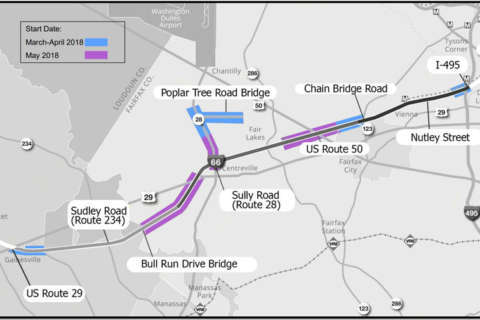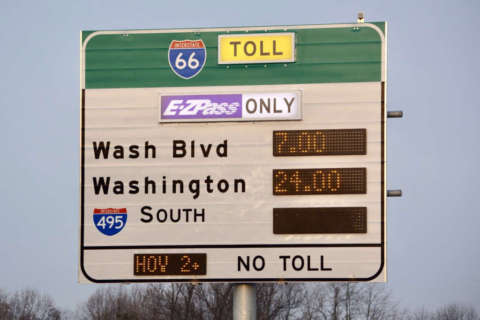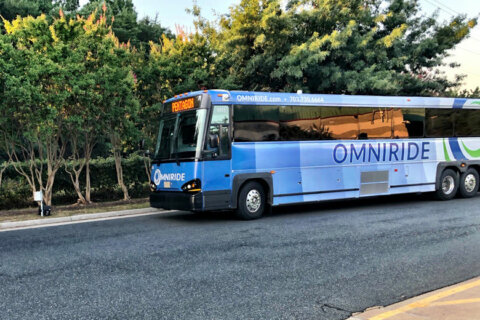WASHINGTON — Expanded high occupancy vehicle lane hours implemented alongside tolling for solo drivers on Interstate 66 inside the Capital Beltway appear to drive the most significant changes to travel times along the corridor, new Virginia Department of Transportation data suggest.
The tolling rules have largely maintained existing traffic flows during the old rush-hour periods compared with a year ago. But they have sped up traffic on the highway during the additional restricted hours when solo drivers now must pay a toll, create a carpool or find another route to work.
Morning commutes on I-66 itself are somewhat faster now than a year ago except between 7 a.m. and 7:30 a.m., when trip times are largely unchanged. The biggest increase in travel times has come during the extended rush-hour periods and on the fringes of the previous HOV hours, when drivers would try to squeeze in just before or after the 2 1/2 hours of restrictions kicked in.
Now, the rules apply for four hours each eastbound in the morning and westbound in the afternoon.
Afternoon trip times on I-66 are relatively unchanged between 4:30 p.m. and 6:30 p.m. Between 3 p.m. and 4 :30 p.m. and between 6:30 p.m. and 7 p.m., cars on I-66 are moving significantly faster than a year ago.
On parallel roads listed in the VDOT report, drivers on U.S. Route 50 face mixed results, but did see trips in March that were slower by a minute or two for most of the main part of the morning rush hour (from around 7 a.m. to 9:15 a.m.).
U.S. Route 29 is faster by a few minutes compared with a year ago for the morning rush, but is more mixed in the afternoon.
Both Route 50 and Route 29 still take far longer in the peak rush-hour direction than a trip the length of the corridor on I-66 at the same time on an average weekday.
George Washington Parkway travel time southbound from the Beltway before 7 a.m. is comparable to the commute time on I-66. Afternoon trips northbound are several minutes slower than using I-66 on average. Morning travel times on the parkway are largely unchanged from a year ago, but traffic stays slower a bit longer after 9 a.m., when the old HOV rules ended on I-66.
In the afternoon, the G.W. Parkway is slightly better than a year ago until 6 p.m., and then basically unchanged.
Virginia Route 7 near I-66 is relatively unchanged from a year ago, but is slightly better at certain times.
Toll rates
Drivers along the corridor appear to be settling in somewhat to new patterns after nearly five months of the rush-hour tolls for people driving alone, which is one reason VDOT is now planning changes to the tolling algorithm.
The average toll paid for an individual trip eastbound in the morning dipped from $8.71 in February to $8.19 in March, and westbound in the afternoon from $4.51 to $4.46. Those averages include shorter trips that are charged a fraction of the posted price for a trip on the entire corridor.
For one of those full trips in the morning, 674 drivers paid $40 or more in March.
Since tolling began Dec. 4, the average morning price paid is now $7.99, and the average afternoon price paid is $4.32. Those numbers have been rising somewhat each month following lower usage in the early months of the tolls and expanded HOV hours.
The total number of trips in the lanes dipped slightly in both the morning and afternoon compared with February.
In March, VDOT recorded an average of 13,656 trips each day during the eastbound tolling hours in the morning and 16,447 trips each day westbound during the tolling hours in the afternoon.
Tolls have been higher in the morning in part because the tolling algorithm factors in the regular slowdown at the Dulles Connector Road merge.
The proportion of drivers without an E-ZPass who face penalties and bills in the mail ticked up slightly to 12.7 percent in a month when out-of-town visitors and spring break vacations for regular commuters are common.
In March, 43.5 percent of trips were taken by drivers with an E-ZPass Flex switched to HOV mode for a free ride, indicating they had at least one other person in the car; 43.8 percent of trips were taken by drivers with a regular E-ZPass or an E-ZPass Flex in toll-paying mode.







